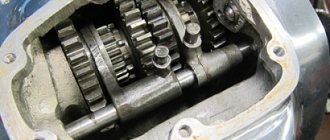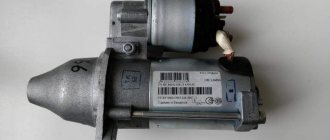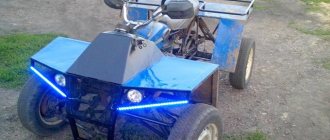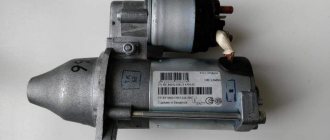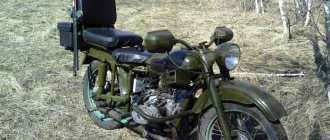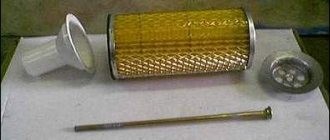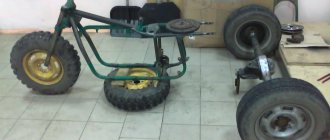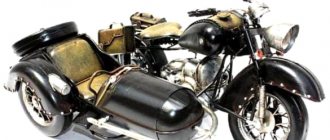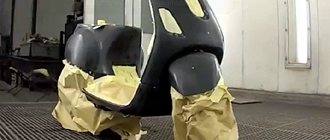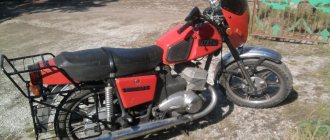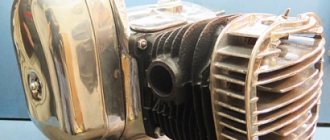A Ural motorcycle has been in the garage since 1998. The motorcycle is separate, the engine is separate, the gearbox is in a completely different corner. I spent my entire childhood on this motorcycle, after buying a car, they forgot about it. And so I decided to restore it...
First, it was decided to deal with the engine, since, according to the owner, the crankshaft was knocking. Therefore, we immediately began disassembling the engine.
Removing the cylinders
I removed the heads, checked the piston clearances in the cylinders, everything was fine, only the right cylinder had a rusty emulsion - apparently moisture had gotten in. But fortunately the cylinder mirror was not damaged.
I checked the gaps on the fingers - everything is within normal limits. I pressed out the fingers, marked where the right and left parts of the cylinders were and put them aside.
Removing the clutch
Then I started disassembling the clutch to remove the flywheel. A simple screwdriver and hammer blows were not enough to unscrew the screws the first time. There is no point in buying an impact screwdriver just for one use. I turned on my ingenuity. And so he pressed the engine from the frontal side into the opening of the garage door, and pressed the screwdriver to the bolt with the help of a block and a jack, and with a gas wrench tore off the metal beads. And then everything opened without problems. I removed the clutch and started disassembling the frontal part, since I didn’t have a 36mm socket wrench on hand to unscrew the flywheel.
Removing the timing belt
In the frontal part, everything is disassembled simply, the cover is unscrewed, the ignition is removed, the ignition coil is removed, then the windshield is unscrewed. I unscrewed the two bolts that hold the camshaft and placed two mounting brackets under the camshaft gear using rags. And he pulled out the camshaft and gear. Upon inspection, no wear was found in the timing gears. The bearing is also in excellent condition. I secured the pushers with electrical tape to prevent them from falling into the crankcase and getting tangled.
Then I went to a friend and took from him a three-legged puller and a 36mm socket wrench. I unscrewed the bolts that hold the crankshaft main bearing in place at the front. And as in the video, I decided to grab the pressure washer with the puller, since the puller’s legs do not fit under the gear. The result is that the gear is removed, the pressure washer is bent and torn. Conclusion, it was necessary to tie steel wire around the gear and pull it. It will be a lesson for the future.
Removing the flywheel
After disassembling the timing belt, I started working on the flywheel. For the flywheel, you need a wrench so that the working edge is straight away, and not, like most heads, slightly recessed, since the flywheel bolt has thin edges. To fix the flywheel, I used a 12mm wrench and inserted one end into the clutch bolt and the other into the stud securing the box to the engine. I’ll say right away that it’s better not to do this, since I bent the pin. It’s better to take a 19-size open-end wrench, insert one end into the hole in the flywheel, and the other into the rod that you need to insert the lugs for attaching the engine to the frame. This is what was done when assembling the flywheel.
When I unscrewed the flywheel bolt, I pulled off the flywheel using a puller. Next, unscrewing the 9 bolts that hold the rear main bearing cover in place, I used the same puller to remove the cover itself. And now the reason for the knocking crankshaft was discovered - the main bearing separator had crumbled.
Removing the crankshaft
To remove the crankshaft, you need to remove the oil pump. To do this, I drained the oil and unscrewed the pan. I unscrewed the top cover of the oil pump and took out the gear. From the bottom of the pan, I removed the pump mesh and unscrewed it and removed it along with the rod, which will not allow the crankshaft to be removed.
Using a wooden mandrel and a hammer, I removed the front main bearing. To do this, the engine was placed on the floor with its back side. I placed a wooden mandrel against the front shank of the crankshaft and, using gentle and gentle blows of a hammer on the mandrel, knocked out the crankshaft from the front main bearing.
Next, to pull the crankshaft out of the engine, I took it by two connecting rods and put it in the position in which the connecting rods are at bottom dead center, then after twisting it a little inside, I pulled it out through the rear cover, and put it in place in the reverse order.
I cleaned the front crankshaft oil catcher of slag with steel wire, and I removed almost the entire main bearing cage from the rear oil catcher. The crankshaft itself had no wear above normal. I washed the inside of the engine with solarium to remove any chips that had formed during operation.
Ural motorcycle engine assembly
I found 207 bearings and assembly began. The first thing I did was put the crankshaft inside, I can’t explain exactly how it gets there, well, a few manipulations and it’s there. It didn’t work the first time, because I didn’t move the connecting rods correctly, and the right connecting rod ended up in the left window, and the left one in the right, so I had to pull it out again and put it back in place.
Then, heating the main bearings with a gas burner, I installed them in place. They finally fall into place when you install the pressure washer on the front (I replaced it with a new one, I did not restore the old one). And on the back is the back cover. To do this, they are first seated with long bolts, and then the original bolts are put in their place. I installed the back cover with sealant so that I wouldn’t have to worry about cutting out a new gasket.
When assembling the back cover, while tightening one of the bolts, it broke off. I had to drill a hole in the broken bolt. I tried to unscrew it first, but it didn't work, so I drilled the hole larger and cut a new thread. In the future, these bolts need to be replaced with new ones, as they tend to break off when tightened.
After that, I installed the timing gears, don’t forget about the lock washers. I did not use thread locker, but pinned the bolts with wire. Since this is my first time assembling and disassembling a Ural engine, I suddenly have to disassemble it again.
The timing gears are placed strictly according to the mark. Next, the breather is installed, the windshield is on top, and I bolt it on. I install the ignition in place, approximately according to the marks where it was. After that, I installed the rear main bearing seal. I installed it at the last moment, only after everything was assembled and checked. In order not to disassemble it again, rubber products do not like this.
I took the oil seal from a repair kit purchased back in the “dashing 90s”, it’s good that it was preserved.
Reinstalled the oil pump. Installed the flywheel and tightened it. Reassembled the clutch. Since there were no long bolts or studs on hand, in order to install the clutch as per the book, I had to press on the discs with my knee and tighten them with the original bolts “cross to cross”. This suggests once again that Soviet equipment can be repaired in the field.
I installed the pistons and cylinders, and mounted the engine on the motorcycle frame. The iron bushings on the engine mounting studs should be on the left. I started to put the box down, but at first it didn’t fit. After the first presses on the kickstarter, the clutch discs clicked, the gearbox shaft entered both discs and the box fell into place. And they started dancing with a tambourine to get him going.
Reasons for repair
The most popular reason to repair a Ural motorcycle is considered to be insufficient dynamics of the motorcycle, smoke from the muffler, loss of traction at high speeds, and a decrease in maximum speed. Reasons that even inexperienced riders can note include increased fuel and oil consumption. If such problems appear, there is no need to disassemble the engine right away; first you should check the ignition, then the carburetor settings, measure the compression and check the valve adjustment, and after eliminating all other problems, you should get into the engine and repair the Ural motorcycle engine.
You might be interested in how to tune a Ural motorcycle. A detailed description of possible directions for tuning a bike!
More experienced owners may suspect a problem by the sound of the engine. Specific noise reveals a number of problems that are determined with high accuracy.
There are also a number of reasons to repair the engine that are not related to its breakdown. For example, the engine can be rebuilt during a long period of inactivity, during restoration, after a long mileage, and so on.
content .. 11 12 17 ..REPAIR OF MOTORCYCLE ENGINES “DNEPR” AND “URAL”
DISASSEMBLY. Let's look at engine disassembly using the example of the Ural M67-36 motorcycle engine. It is carried out in the following order: remove the gearbox by unscrewing the stud nuts and the bolt securing the gearbox to the engine crankcase; disconnect the suction pipe and remove the carburetor with the gasket, the cylinder head cover and its gasket, having previously placed a tray under the connector to drain the oil remaining in the cylinder head cover.
For further disassembly, install the piston in the disassembled cylinder at the top. so that both valves are closed, turn the crankshaft - using a special handle (see Appendix Fig. 2).
Having unscrewed the nuts securing the brackets, remove the rocker arms with the axle brackets, and remove the pusher rods. After this, remove the gasket and cylinder head stuck to the cylinder with a light blow of a hammer on a wooden block or non-ferrous metal mandrel attached to the head. When separating the head from the cylinder, you need to ensure that the gasket is separated. If one part of the gasket comes off along with the head, and the other remains in the cylinder, then use a knife to separate it from the cylinder. When removing heads, especially both at the same time, you should mark the parts so as not to confuse them during assembly.
Having unscrewed the nuts securing the cylinder, gently rock it and gently move it without jerking, so as not to tear the paper gasket, and remove the cylinder.
When removing the piston, use the devices shown in Figure 15.
To remove the pushers with guides, unscrew the locking screws and remove the pushers with guides. Then take out the pushers and mark them so as not to mix them up during assembly.
Unscrew the screws securing the front cover and remove it. Disconnect the wires from the ignition coil terminals, remove the breaker cover and remove the high voltage wires along with the rubber bushings. Unscrew the bolt securing the ignition timing automatic and remove it together with the breaker cams. After unscrewing the fastening screws and sliding them with light blows, remove the cover and take out the breather. If the gasket is damaged, it is removed. If it is necessary to inspect and disassemble the lube bypass valve, keep in mind that it
strictly calibrated for pressure in the lubrication line of 70...90 kPa.
Before removing the camshaft, measure the engagement gap and the end runout of the timing gears. To do this, unscrew the mounting nuts and remove the generator. Install the device on the upper right threaded hole and measure the lateral clearance in the meshing of the gears, which should not exceed 0.3 mm (Fig. 31). If the gap is increased, the gears are replaced. Attach the device to the right threaded hole (Fig. 32) and measure the end runout of the gears, which should not be more than 0.04 mm.
To remove the camshaft, remove the flange mounting screws through the holes of the driven distribution gear. To remove the shaft, use a drift and hammer (see Fig. 21) or a special mandrel-puller,
which is inserted into the hole of the removed intake valve guide sleeve of the left cylinder. By bringing the mandrel under the camshaft cam, by turning it, press out the shaft and remove it from the crankcase.
Before removing the flywheel, bend the lock washer of the flywheel bolt and install a 19x22 wrench in the spacer between the hole for the spring in the flywheel and the boss under the engine crankcase mounting stud. Using a key, unscrew the flywheel mounting bolt, remove the lock washer and remove the key. Fix the device (see Fig. 19, a) on the flywheel and, screwing in the central screw of the device, remove the flywheel from the crankshaft cone.
To remove the crankshaft from the crankcase, first remove the drive gear (see Fig. 19.6) and remove the key. Before removing the crankshaft, unscrew the bolts securing the front bearing housing, remove the washers and cover, then unscrew and unscrew the bolts securing the rear bearing housing, remove the washers and rear bearing housing (Fig. 33, a) and press the crankshaft out of the front bearing with a puller (Fig. . 33.6). After this, turn the crankshaft in the engine crankcase with your left hand until it stops, lifting it up, and with your right hand move the connecting rod towards the left hole of the crankcase and remove the crankshaft from the crankcase. If inspection and replacement of parts are not required, the front bearing housing is not removed.
The bearing is removed from the crankshaft rear journal journal using a puller. If the bearing has been removed from the crankshaft journal along with the rear housing, then the bearing is pressed out using a manual press using a mandrel. If necessary, press the front housing with the bearing out of the crankcase and then the bearing from the front housing using a hand press, using a mandrel and a ring.
For Ural and Dnepr-12 motorcycle engines, after removing the crank mechanism from the crankcase, measure the radial clearance in the lower head of the connecting rod with an indicator; it should not exceed 0.1 mm. If the gap is larger, the crank mechanism must be disassembled.
For the Dnepr K-650, MT-9 and MT-10-36 motorcycle engines, unscrew the centrifuge mounting bolt, remove the washer, as well as the paper and rubber gaskets, and screw a plug tip into the hole in the end of the crankshaft. Remove the centrifuge body with the lid using a universal puller (Fig. 34). Disconnect the lid from the centrifuge body and remove the screen. The remaining operations are similar.
To remove cylinders from K-750 engines, remove the screws securing the valve box covers, remove the covers and their gaskets. Unscrew the cylinder fastening nuts and carefully remove the cylinders with valves and gaskets. Then remove the pistons, pushers with guides and the generator. Remove the front crankcase cover, move the breaker cover holder with the strip aside, and remove the distributor cover. Unscrew the rotor mounting screw and remove it from the camshaft. The further process of disassembling the K-750 engines is not difficult.
After disassembly, the parts are washed, cleaned of carbon deposits, carefully inspected and the necessary measurements taken. If necessary, worn parts are replaced or repaired.
content .. 11 12 17 ..
Choosing a case that suits your needs
Having set the goal of tuning a Ural motorcycle with your own hands, it is important to understand that there are modifications that are relatively painless and do not require documentary evidence to register the vehicle and undergo a technical inspection.
And there are changes that, in order not to conflict with the law, must be agreed upon with the manufacturer or other regulatory authorities. Based on this, tuning for a Ural motorcycle should be divided into two categories:
We will consider each of these categories separately.
Motor defective
The process of disassembling the motor is quite complicated, but what is more important is that the existing gaps “go away.” Thus, if you disassemble the motor and then reassemble it without repair, extraneous noise is likely to appear due to the increase in gaps. Therefore, experienced mechanics advise, first of all, to assess the condition of the motor without disassembling the main elements, or to carry out a partial disassembly, then carry out troubleshooting and, based on its results, decide whether to make repairs or not. A malfunction can be determined “by ear” if:
Reason: wear of the piston pin and the appearance of an excessively large gap between the pin and the bushing. Solution: first of all, you can set the ignition later, in some cases this either completely eliminates the noise, or it becomes insignificant, which allows you to use the motorcycle for some time. If this does not help, then the old pins are replaced with new ones, as well as the connecting rod bushings with their subsequent development.
Reason: the appearance of a gap between the pin and the piston boss. Solution: replace the pin + piston set with new ones of the same group.
Reason: clearance between piston and cylinder. Solution: selecting a new piston of the next repair size and boring the cylinder for a new piston group.
Reason: This sound may indicate an increase in the gap between the lower end of the connecting rod and the crankshaft crank pin.
By the behavior of the motorcycle you can find out about the following problems:
Cause: worn piston rings. Solution: complete replacement of the piston rings, and if there is damage to the cylinder plane, boring it, with subsequent repairs.
Owners of the Ural motorcycle most often encounter similar problems. As you can see, most problems are diagnosed by craftsmen “by ear”, and despite all the primitiveness, the result turns out to be very accurate. Assuming there is a problem with the motor, you should stock up on a set of necessary pullers, keys and repair parts, and only then begin disassembly.
avtorep.ru
A Ural motorcycle has been in the garage since 1998. The motorcycle is separate, the engine is separate, the gearbox is in a completely different corner. I spent my entire childhood on this motorcycle, after buying a car, they forgot about it. And so I decided to restore it...
First, it was decided to deal with the engine, since, according to the owner, the crankshaft was knocking. Therefore, we immediately began disassembling the engine.
Removing the cylinders
I removed the heads, checked the piston clearances in the cylinders, everything was fine, only the right cylinder had a rusty emulsion - apparently moisture had gotten in. But fortunately the cylinder mirror was not damaged.
I checked the gaps on the fingers - everything is within normal limits. I pressed out the fingers, marked where the right and left parts of the cylinders were and put them aside.
Removing the clutch
Then I started disassembling the clutch to remove the flywheel. A simple screwdriver and hammer blows were not enough to unscrew the screws the first time. There is no point in buying an impact screwdriver just for one use. I turned on my ingenuity. And so he pressed the engine from the frontal side into the opening of the garage door, and pressed the screwdriver to the bolt with the help of a block and a jack, and with a gas wrench tore off the metal beads. And then everything opened without problems. I removed the clutch and started disassembling the frontal part, since I didn’t have a 36mm socket wrench on hand to unscrew the flywheel.
Removing the timing belt
In the frontal part, everything is disassembled simply, the cover is unscrewed, the ignition is removed, the ignition coil is removed, then the windshield is unscrewed. I unscrewed the two bolts that hold the camshaft and placed two mounting brackets under the camshaft gear using rags. And he pulled out the camshaft and gear. Upon inspection, no wear was found in the timing gears. The bearing is also in excellent condition. I secured the pushers with electrical tape to prevent them from falling into the crankcase and getting tangled.
Then I went to a friend and took from him a three-legged puller and a 36mm socket wrench. I unscrewed the bolts that hold the crankshaft main bearing in place at the front. And as in the video, I decided to grab the pressure washer with the puller, since the puller’s legs do not fit under the gear. The result is that the gear is removed, the pressure washer is bent and torn. Conclusion, it was necessary to tie steel wire around the gear and pull it. It will be a lesson for the future.
Removing the flywheel
After disassembling the timing belt, I started working on the flywheel. For the flywheel, you need a wrench so that the working edge is straight away, and not, like most heads, slightly recessed, since the flywheel bolt has thin edges. To fix the flywheel, I used a 12mm wrench and inserted one end into the clutch bolt and the other into the stud securing the box to the engine. I’ll say right away that it’s better not to do this, since I bent the pin. It’s better to take a 19-size open-end wrench, insert one end into the hole in the flywheel, and the other into the rod that you need to insert the lugs for attaching the engine to the frame. This is what was done when assembling the flywheel.
When I unscrewed the flywheel bolt, I pulled off the flywheel using a puller. Next, unscrewing the 9 bolts that hold the rear main bearing cover in place, I used the same puller to remove the cover itself. And now the reason for the knocking crankshaft was discovered - the main bearing separator had crumbled.
Removing the crankshaft
To remove the crankshaft, you need to remove the oil pump. To do this, I drained the oil and unscrewed the pan. I unscrewed the top cover of the oil pump and took out the gear. From the bottom of the pan, I removed the pump mesh and unscrewed it and removed it along with the rod, which will not allow the crankshaft to be removed.
Using a wooden mandrel and a hammer, I removed the front main bearing. To do this, the engine was placed on the floor with its back side. I placed a wooden mandrel against the front shank of the crankshaft and, using gentle and gentle blows of a hammer on the mandrel, knocked out the crankshaft from the front main bearing.
Next, to pull the crankshaft out of the engine, I took it by two connecting rods and put it in the position in which the connecting rods are at bottom dead center, then after twisting it a little inside, I pulled it out through the rear cover, and put it in place in the reverse order.
I cleaned the front crankshaft oil catcher of slag with steel wire, and I removed almost the entire main bearing cage from the rear oil catcher. The crankshaft itself had no wear above normal. I washed the inside of the engine with solarium to remove any chips that had formed during operation.
Ural motorcycle engine assembly
I found 207 bearings and assembly began. The first thing I did was put the crankshaft inside, I can’t explain exactly how it gets there, well, a few manipulations and it’s there. It didn’t work the first time, because I didn’t move the connecting rods correctly, and the right connecting rod ended up in the left window, and the left one in the right, so I had to pull it out again and put it back in place.
Then, heating the main bearings with a gas burner, I installed them in place. They finally fall into place when you install the pressure washer on the front (I replaced it with a new one, I did not restore the old one). And on the back is the back cover. To do this, they are first seated with long bolts, and then the original bolts are put in their place. I installed the back cover with sealant so that I wouldn’t have to worry about cutting out a new gasket.
When assembling the back cover, while tightening one of the bolts, it broke off. I had to drill a hole in the broken bolt. I tried to unscrew it first, but it didn't work, so I drilled the hole larger and cut a new thread. In the future, these bolts need to be replaced with new ones, as they tend to break off when tightened.
After that, I installed the timing gears, don’t forget about the lock washers. I did not use thread locker, but pinned the bolts with wire. Since this is my first time assembling and disassembling a Ural engine, I suddenly have to disassemble it again.
The timing gears are placed strictly according to the mark. Next, the breather is installed, the windshield is on top, and I bolt it on. I install the ignition in place, approximately according to the marks where it was. After that, I installed the rear main bearing seal. I installed it at the last moment, only after everything was assembled and checked. In order not to disassemble it again, rubber products do not like this.
I took the oil seal from a repair kit purchased back in the “dashing 90s”, it’s good that it was preserved.
Reinstalled the oil pump. Installed the flywheel and tightened it. Reassembled the clutch. Since there were no long bolts or studs on hand, in order to install the clutch as per the book, I had to press on the discs with my knee and tighten them with the original bolts “cross to cross”. This suggests once again that Soviet equipment can be repaired in the field.
I installed the pistons and cylinders, and mounted the engine on the motorcycle frame. The iron bushings on the engine mounting studs should be on the left. I started to put the box down, but at first it didn’t fit. After the first presses on the kickstarter, the clutch discs clicked, the gearbox shaft entered both discs and the box fell into place. And they started dancing with a tambourine to get him going.
A little history
The products of the Irbit Motorcycle Plant are well known not only in our country. Various models, whose design originates from the pre-war BMW R71, have retained their parental genes for seventy years. True, the prefix “Ural” appeared in their name a little later. Since 1961, it has been assigned to the following modifications:
Next, it was decided to limit ourselves to the name Ural, removing the additional digital index and leaving only the factory designation.
And this is not counting special versions and limited editions. But in the process of tuning a motorcycle, any of the listed modifications have a lot in common. Despite the changes in the name, all models are similar in design and have similar technical characteristics.
Dismantling the Ural motorcycle engine
Repair of a Ural motorcycle should be carried out in stages. The first step is to prepare your garage and the engine itself. All dirt and oil must be washed off the engine so that they do not get inside. Laying a film on the floor will help protect the garage floor, because it is easier to throw away a piece of cellophane than to remove the remaining grease from the garage floor. Disassembly process:
Following this diagram, you will be able to get to the main parts of the engine in order to conduct a full diagnostic of the gaps and, if necessary, replace the parts with new ones. It is worth noting that if a part has a gap close to wear, then it is better to replace it, since most new spare parts lead to increased load on the entire engine while it is running in. Such increased pressure on old components can lead to their wear, which means the appearance of noise.
We recommend carrying out comprehensive repairs before the start of the season. This approach will allow you to get rid of all problems with mismatched gaps and skate several seasons without worries. Otherwise, the motorcycle engine may break down at the height of the season and make it impossible to move on two wheels for a long time.
How to disassemble the engine on a Ural motorcycle
Dismantling the engine of motorcycles Ural, Dnepr
We will consider disassembling the engine using the example of the engine of the Ural M67-36 motorcycle.
— remove the gearbox by unscrewing the stud nuts and the bolt securing the gearbox to the engine crankcase;
— disconnect the suction pipe and remove the carburetor with the gasket;
— dismantle the cylinder head and its gasket, having previously placed a container under the connector to drain the oil;
— set the piston of the cylinder being disassembled to top dead center so that both valves are closed, turning the crankshaft;
— having unscrewed the nuts securing the brackets, remove the rocker arms with the axle brackets, remove the pusher rods;
- Separate the head from the cylinder with light blows of a hammer through a wooden block; you must ensure that the gasket separates along with one of the parts and does not tear. When removing both heads, you need to mark the parts being removed so as not to confuse them during assembly;
— unscrew the fastening nuts and remove the cylinder by rocking from side to side;
— remove the piston using the tools shown in Fig. 2.55. In this case, first remove the piston pin retaining rings, then put the device on the piston and install it on the cylinder mounting studs and press out the piston pin;
— remove the pushers with guides, having first unscrewed the locking screws, remove the pushers, mark them;
— remove the front cover by unscrewing the screws securing it;
— disconnect the wires from the ignition coil terminals;
— remove the breaker cover, remove the high voltage wires along with the rubber bushings;
— remove the ignition timing device together with the cams and the breaker;
— remove the cover, remove the breather.
To remove the camshaft, it is necessary to unscrew the screws securing the flange through the holes of the driven distribution gear; the shaft is dismantled using a puller, which is inserted into the hole of the removed guide sleeve of the intake valve of the left cylinder of the gears (Fig. 2.58). Place the timing mandrel under the cam and push out the camshaft by turning the mandrel counterclockwise.
To remove the flywheel, you need to bend the lock washer of the flywheel bolt, install a 19x22 key in the spacer between the hole for the spring in the flywheel and the boss under the engine crankcase mounting stud, unscrew the flywheel mounting bolt, remove the lock washer and remove the key. Then fix the device (Fig. 19, a) on the flywheel and screw in the central screw of the device, remove the flywheel from the crankshaft cone.
To dismantle the crankshaft from the crankcase, you must first remove the drive gear (Fig. 19, b), remove the key, unscrew the bolts securing the front bearing housing, remove the washers and cover, then unpin and, having unscrewed the bolts securing the rear bearing housing, remove the washers and housing rear bearing. Then press the crankshaft out of the front bearing (2.59, a) using a puller. After this, turn the crankshaft in the engine with your left hand until it stops, lifting it up, and with your right hand move the connecting rod towards the left hole of the crankcase, remove the crankshaft from the crankcase. If not
When checking and replacing parts is required, there is no need to remove the front bearing housing.
The bearing is removed from the crankshaft rear journal journal using a puller. If necessary, press the front housing together with the bearing out of the crankcase, and then remove the bearing from the front housing using a hand press. After disassembling, the parts must be washed in kerosene, cleaned of deposits and carbon deposits, and inspected. Replace worn parts with new ones or repair them.
Source

